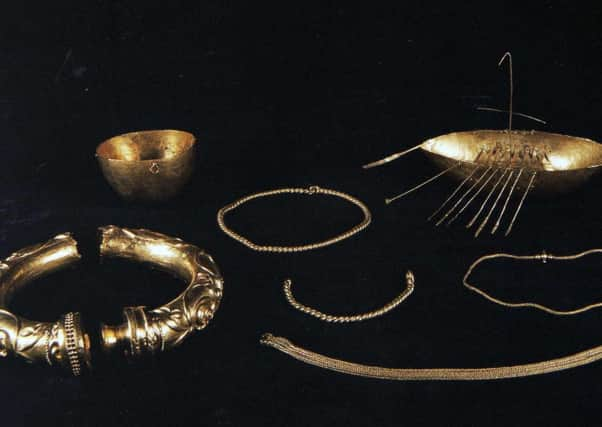The Broighter gold is not from Limavady


Perhaps the most beautiful and undoubtedly amongst the most significant archaeological finds ever discovered in Ireland, the hoard of ancient, golden artefacts discovered in the townland of Broighter by two ploughmen over a century ago is not an assortment of Irish artefacts at all. It is a continental import.
The Broighter hoard, particularly the torque necklace, has been used as a unique symbol of Celtic Ireland but an analysis of the metals reveals a fascinating insight into the networks between those Celts on the periphery of the ancient world - in Ireland - and those on the continental mainland.
Advertisement
Hide AdAdvertisement
Hide AdThe hoard itself was ploughed up at Broighter, just outside Limavady, in 1896 by local men Tom Nicholl and James Morrow.
It was sold to a jewellers, and after a lengthy court case, in 1903 it found its way to the National Museum in Dublin, where it has remained on permanent display - until, of course, its return to Limavady this week. It has been dated to the Iron Age, most likely from the first century BC.
Its return has been hailed as the Broighter gold’s ‘homecoming’. However, it could be argued that its true origins are probably Mediterranean, or European, and that it was merely imported to the shores of the Foyle over two thousand years ago. The composition of the metal reveals a ‘significant platinum impurity’ which points emphatically towards a foreign origin.
The hoard is about as fine an example possible of the form of goldworking from the Celtic culture known as ‘La Tene’, named after the site were rich cache of artefacts were uncovered in 1857. La Tene culture flourished throughout Europe in the Iron Age, including parts of Ireland and Britain, northern Spain, Burgundy, and Austria.
Advertisement
Hide AdAdvertisement
Hide AdThe Broighter hoard is an example of the type of goldworking typifying the La Tene culture. The Mediterranean metals discovered in the artefacts gives us an insight into what must have been a thriving Celtic culture of that time and provides material evidence of a network of communication from the Celtic heartlands of Europe to the very edge of their world, the North West of Ireland.
The design of the torque, however, is of a design unique to Ireland. ‘The Celtic World’, a work edited by Miranda Green and published in December last year, gives an analysis of the hoard and what it reveals about the workings of Celtic culture in the Iron Age: “The Broighter hoard is a remarkable assemblage whose find circumstances have been the subject of controversy, although it is now accepted as a genuine hoard. It contains undoubted imports in the form of wire bracelets from the Eastern Mediterranean but the other objects are more difficult to assess.”
The entire hoard, however, is unlikely to have been imported. The book continues: “Two twisted rod bracelets may be local copies of Roman types but in the apparent absence of a substantial gold industry in Ireland at this time this must be uncertain.
“The famous tubular torque uses techniques, such as the use of the beaded wires joined to small gold beads, which are not part of Celtic goldworking anywhere in Britain but, on the other hand, it is decorated in a distinctly Irish style. The most plausible answer is that the torque has a continental origin and its body was either renewed or at least decorated in Ireland.”
Advertisement
Hide AdAdvertisement
Hide AdAnother famous part of the hoard, the golden boat which was considered ‘too delicate’ to make the move from Dublin and is therefore, disappointingly, not goinf to be on display at the Roe Valley Arts and Cultural Centre along with the rest of the hoard, is also examined in ‘The Celtic World’. “The boat must have been modelled on typical Celtic ships, such as those of the Veneti referred to by Caesar. Model boats in precious metal have a long history, with a fourth-century BC model canoe from Hallein in Austria and the twelfth-eleventh-century BC gold ornamented shale model from Caergwrle in north-east Wales.
“The analyses of the Broighter gold show a significant platinum impurity which has been associated with both European and Mediterranean sources.”
While the boat is to stay in Dublin because it is considered too precious to make the move, the rest of the Broighter hoard is well worth a visit, even if it is an import.